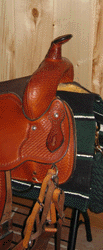
Article
-
Saddle Rigging Demystified
Rigging is quite basic in concept, it's basic function is to attach the saddle to the horse. However while installing the rigging the saddlemaker must be careful and precise in order to do it correctly lest the performance of the horse or the comfort and safety of the rider be compromised.
Most rigging configurations are elegant in their design. By that I mean the design is straightforward yet significantly afffects the performance and comfort of both horse and rider. Regardless of the rigging configuration the saddlemaker must take great care to correctly incorporate the rigging into the saddle tree and/or skirt.
I won't go into detail regarding a description of the base rigging (the part you don't see) although it's always a bonus to know how things work and why they are designed the way they are - knowledge is power after all.
**********
It's called Center Fire rigging and requires a rather wide cinch (6-8 inches) to keep everything in place.
Like so many other parts of a saddle, the rigging got to where it is today largely through evolution. Someone would change something that needed changing, experiment a bit, and come up with a new "design".
The use of the saddle would often dictate the need for changes in the rigging.
With the advent of the saddle horn as an aid in roping, center fire rigging was found to have some disadvantages. Rope the calf and stop the horse and the saddle would tend to be pulled forward with the cantle rising. The answer to the problem was found in Full Rigging where the position of the cinch is directly below the fork or pommel rather than at the center of the seat.
Tightening the cinch on a full-rigged saddle actually pulls the saddle forward slightly while also pulling it down so the saddle is pulled into the low part of the horses back. If you look closely at the full-rigged saddle you'll note that the cinch doesn't drop straight down but comes forward at a slight angle, going around the horse's sternum rather than the center of the belly.
Full rigging still had some disadvantages as a roping saddle and as a recreational saddle when traveling over rough terrain. The cantle would tend to rise when going downhill or roping a calf.
Texas cowboys are credited with solving the problem by the addition of a billet or back cinch attached in a line below the cantle. Add the back cinch and you have Double Rigging, with a front cinch only you have Single Rigging.
Further refinements were made with the perfomance of the horse or comfort of the rider in mind, or both. If your cinch is halfway between the cantle and the pommel you have Center Fire Rigging, if the cinch is under the pommel you have Full Rigging - but you know that already.
What if the cinch is three quarters of the way from the cantle? The answer - a Three Quarters Rigged saddle. Seven eights of the distance (i.e. about at the rear of the pommel - a Seven Eights Rigged saddle).
What about a saddle with a rear cinch only? I haven't seen any write-ups on that one although somewhere along the line someone may have experimented with the idea. They may not have lived to tell about it! In any event don't try it.
**********
Now you can impress your friends with your knowledge of saddlery by taking them with you to the saddle shop and asking to see what they have in the way of a "seven-eights single rigged saddle". You likely won't impress the shop owner since that's how the majority of saddles are rigged nowadays. Actually seven-eights with either single or double rigging are the most popular configurations.
You could also ask for a double rigged center fire saddle in which case the shop owner would likely roll his eyes and talk about you long after you've left. The reason - with center fire rigging a back cinch is so close to the front cinch that it serves no practical purpose.
Single or Double Rigging? Double rigging adds stability which is an advantage if you're going to be riding in very rough couontry (ups and downs) much of the time. Otherwise, the back cinch is "just another piece of leather to worry about" according to some, and they prefer single rigging for that reason.
There are several ways in which rigging is attached to the tree or the skirt. If you're buying a quality saddle I wouldn't worry too much about O-rings, D-rings, or plates. Sit in the saddle make certain the rigging hardware under the skirt doesn't interfere with your morement or comfort and then decide if seven-eights or whatever is right for you.
Copyright © 2005 W. Savage. All Rights Reserved.
William "Bill" Savage, a retired, engineer lives on the Goose Bay Ranch in Montana where he spends time with family, horses, and his web site. You can read other articles of his including those on horsemanship on his web site https://www.your-guide-to-gifts-for-horse-lovers.com